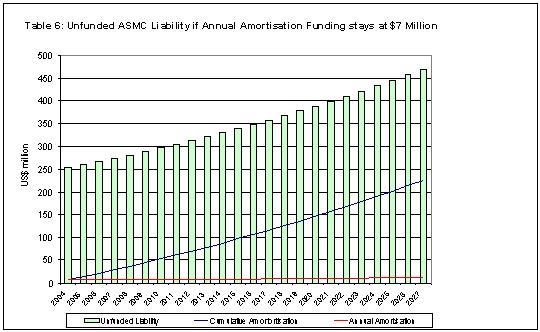FC 108/11a ii) |
FC 108/11a ii) |
Hundred and Eighth Session |
Rome, 27 September – 1 October 2004 |
Summary History on Staff-Related Liabilities |
1. In the last several years, the Committee has examined and proposed various actions in connection with staff-related liabilities. The main documents considered were FC 104/10, FC 97/9, FC 96/12, FC 90/9 and FC 89/14. At its 107th Session in May 2004 the Committee considered document FC 107/13 and asked to be kept up to date. The Secretariat presents below the updated information on all 4 schemes of the staff-related liabilities as reported in the FAO Audited Accounts 2002/03 (C 2005/5 A) and as based on the latest actuarial valuations at 31 December 2003.
2. After Service benefits are the staff members’ entitlements which become payable at the end of service. In FAO, these are comprised of the following (please also see FC 108/11 (b)):
3. Table 1 shows the funded and unfunded liabilities for each Staff Related Scheme, according to the financial statements and actuarial valuations, as well as the total recorded liabilities for all schemes at 31 December 2003 compared with the same date in 2001 and 1999.
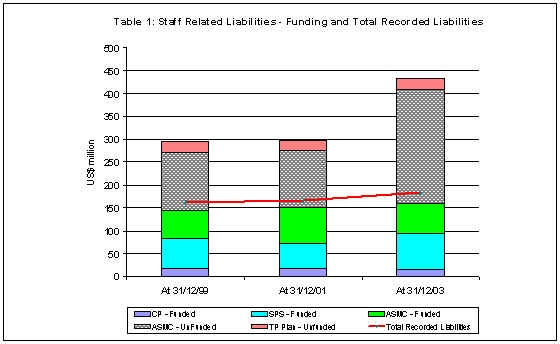
4. As shown in Table 1, the ASMC liability increased significantly from 31 December 2001 to 31 December 2003. The Committee discussed this increase at its 107th Session in May 2004 (please also see the Finance Committee’s report in CL 127/14, paragraphs 14 to 16) and noted that a change in methodology for the 2002/03 actuarial valuation had been necessary because prior biennia calculations, based on a single valuation for all the Rome-based UN agencies, carried a notional apportionment of retirees amongst the agencies which did not reflect actual populations. The Committee had also recognized that future calculations should not fluctuate so significantly.
5. Table 2 shows the total annual current service cost (i.e. accrued cost of active staff liability charged to the regular budget) from the latest 2003 actuarial valuation which is now being charged in the 2004/05 biennium, compared with the charges for the 2000/01 and 2002/03 biennia.
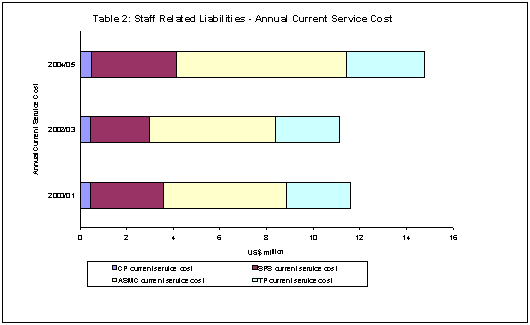
6. Table 3 shows the estimated liabilities for each staff related scheme at the end of the 2004/05 biennium compared to the liabilities for the previous three biennia. The table is based on the ASMC assumptions used the latest 2003 actuarial valuation, with ASMC liabilities of 1998/99 and 2000/01 restated based on actual numbers of active staff and retirees.
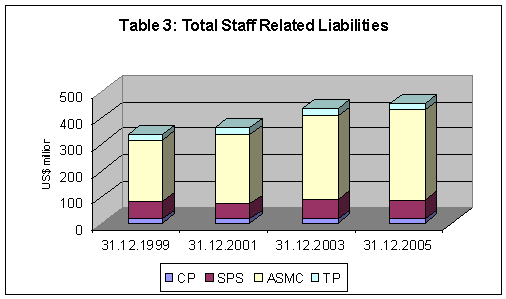
7. The SPS liability is completely denominated in Euro, the currency applicable to the HQ General Service staff salaries. Table 4 compares the SPS liability of the accounting currency, US$, and the underlying currency, Euro. As can be seen from the table, the liability in the base currency, Euro, is actually on the decline whereas the liability when stated in US$ fluctuates based on the applicable exchange rates at the end of each valuation period.
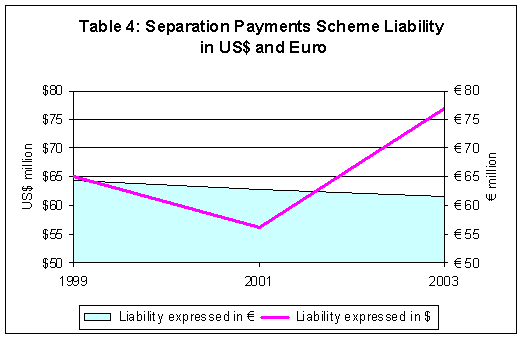
8. TPF liabilities in respect of the past service of staff members are being accrued from 1 January 1998 over an amortisation period of 15 years. In addition to the current service cost, the TPF amortisation is also being charged to the regular budget. In recent years however, the actual cash disbursements of TPF liabilities have exceeded the total of current service cost and amortisation charges. The basis of the actuarial assumptions is under review by the Actuaries.
9. As its 107th Session in May 2004, the Committee noted that the partial funding of US$14.1 million approved by the Conference in 2003 towards the ASMC liability in 2004/05 would need to increase to US$30 million for 2006/07 to offset the increased biennial amortisation for ASMC. The need to adjust the amount of biennial funding in accordance with the latest actuarial valuation was recognized by the Council when it endorsed the Finance Committee’s recommendation in 2003 to include $14.1 million in the 2004-05 Budget Resolution towards the ASMC liability. Paragraph 37 of the Report of the Council’s 125th Session is reproduced below:
Liabilities for After-Service Medical Costs
37. The Council noted that the Finance Committee considered that the current arrangements for funding After-Service Medical Costs (ASMC) liabilities were clearly insufficient and that the issue needed to be addressed as a matter of urgency. The Council endorsed the Finance Committee’s recommendation that the 2004-05 Budget Resolution include an amount of US$14.1 million to offset the amount of the liability to be amortized during the biennium, according to the biennial actuarial valuation, and that this amount should be reviewed in each subsequent biennium and adjusted accordingly to reflect the current valuation.

10. Table 5 shows the effect on the unfunded ASMC liability (which amounted to US$247 million at 31 December 2003) with the latest calculation of annual and cumulative amortisation payments, when funding matches amortisation for each biennium.
11. An illustration of the effect of insufficient funding is shown in Table 6 which shows current biennium funding of $14.1 million, rising only with pensionable remuneration, over a period of 24 years.
